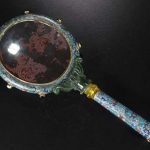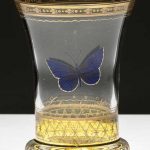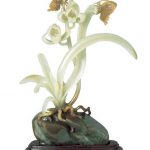Chinese Cloisonne Butterflies. Cloisonne reached China in the 13–14th centuries; the first written reference is in a book of 1388, where it is called “Dashi ware”. No Chinese pieces clearly from the 14th century are known, the earliest datable pieces being from the reign of the Xuande Emperor (1425–35), which however show a full use of Chinese styles suggesting considerable experience in the technique. It was initially regarded with suspicion by Chinese connoisseurs, firstly as being foreign, and secondly as appealing to feminine taste. However, by the beginning of the 18th century the Kangxi Emperor had a cloisonné workshop among the many Imperial factories. The most elaborate and highly valued Chinese pieces are from the early Ming Dynasty, especially the reigns of the Xuande Emperor and Jingtai Emperor (1450–57), although 19th century or modern pieces are far more common. The Chinese industry seems to have benefited from a number of skilled Byzantine refugees fleeing the Fall of Constantinople in 1453, although based on the name alone, it is far more likely China obtained knowledge of the technique from the middle east. In much Chinese cloisonné blue is usually the predominant colour, and the Chinese name for the technique, jingtailan (“Jingtai blue ware”), refers to this, and the Jingtai Emperor. Quality began to decline in the 19th century. Initially heavy bronze or brass bodies were used, and the wires soldered, but later much lighter copper vessels were used, and the wire glued on before firing. The enamels compositions and the pigments change with time. Reference: Wikipedia
Below are some examples of Chinese cloisonne objects with butterflies in their design.
Chinese Cloisonné Enamel Snuff Bottle Qing Dynasty The rounded rectangular form raised on a straight oval foot and surmounted by a tall cylindrical neck, each side with a yellow ground square vignette depicting a cricket and cabbage on one side and butterfly and flowers on the reverse, surrounded by lotus scrolling all reserved on a turquoise ground, above a lappet band at the base. Height 2 1/2 inches.
Sold for $593 (includes buyer’s premium) at Doyle New York in 2018
A CLOISONNE BUTTERFLY PAINTED LONG HANDLE MIRROR
Qing Dynasty 17-19 Century / Weight 513.3g / Length 11.02 in / Width 4.92 in / Thickness 0.79 in
Sold for $4,000 at Empire Auction House, Inc. in 2019
A pair of Chinese cloisonné enamel vases on mounts Qing dynasty, 19th century each of baluster shape, the exterior depicting birds perched on blossoming and fruiting branches with flying butterflies, the shoulders with hanging bats between ruyi pendants and stylised lotus scrolls, the neck decorated with lotus sprays amongst multi-coloured meandering foliage, all between further lotus scrolls at the foot and a ruyi-cloud border encircling the rim, all against a bright blue ground, set on gilt-bronze mounts Quantity: 2 70 cm, 27 1/2 in.
Sold for 17,500 GBP at Sothebys in 2019
A pair of cloisonné enamel tripod incense burners and covers, ding Qianlong Each cast with a robust body with deep rounded sides rising to a galleried rim surmounted by a pair of arched handles, all supported on three legs in the form of trunks issuing from gilt-bronze Buddhist lion masks, the exterior brightly decorated in vivid enamels of red, green, yellow, white, blue and purple on a turquoise ground with archaic taotie masks interspersed with clusters of flowers and a hovering butterfly, the underside with a radiating yin-yang medallion amidst crashing waves, the domed cover with a raised central panel similarly enamelled, surmounted by a gilt openwork finial cast with a sinuous dragon amidst swirling clouds. Each 31cm (12 1/4in) high. (4).
Sold for HK$ 500,000 (£ 51,691) inc. premium at Bonhams in 2016
A RARE LARGE CHINESE IMPERIAL CLOISONNE ENAMEL SQUARE ICE CHEST QIANLONG PERIOD (1736 – 1795) The deep tapering sides decorated with a dense pattern of butterflies and insects in flight amidst scattered flowers divided into three registers by two ribs inlaid with polychrome enamel lotus scroll, the middle register fitted on two sides with two pairs of C-scroll handles with knocking bosses beneath, with a key-fret band at the rim and another around the rim of the similarly decorated, two-part hinged cover, one side pierced with two cash motifs for the emission of chilled air, the interior lined with pewter and wood 27 1/8 in. (68.8 cm.) square, 19¼ in. (48.9 cm.) high, wood stand (2)
Sold for USD 567,500 at Christie’s in 2004
3 Piece French Bronze Mounted Chinese Cloisonne Console Set. Chinese cloisonne pair of baluster form vases and matching ovoid fernery, has blue panels with flowers, leaves, insects, butterflies, oriental pheasants, song birds and peacocks, has intricate colorful filigree borders with goldstone highlights. Pierced decorated gilt bronze mounted bases have figural dragon feet, bronze mounted collars with mythical dragon handles on the shoulders of the fernery. Overall excellent condition. Fernery: 11.5 in. high x 16 in. wide x 11 in. deep – Vases: 14 in. high. Weight: 26.5 lbs.
Sold for $4,000 at Fontaine’s Auction Gallery in 2019








